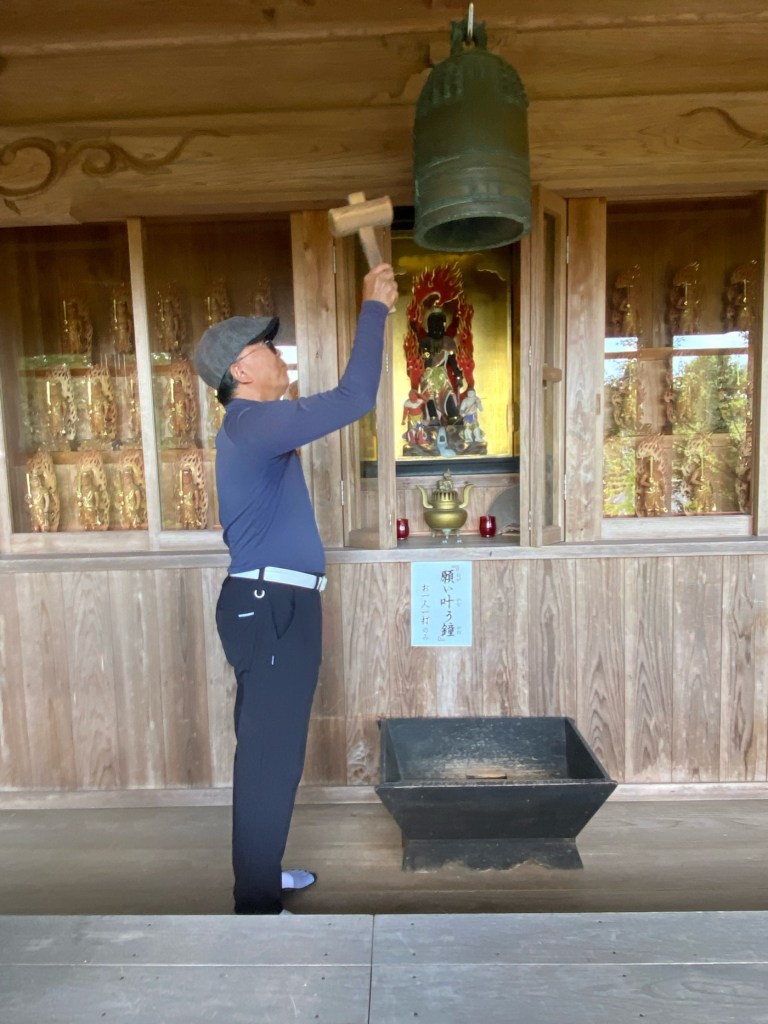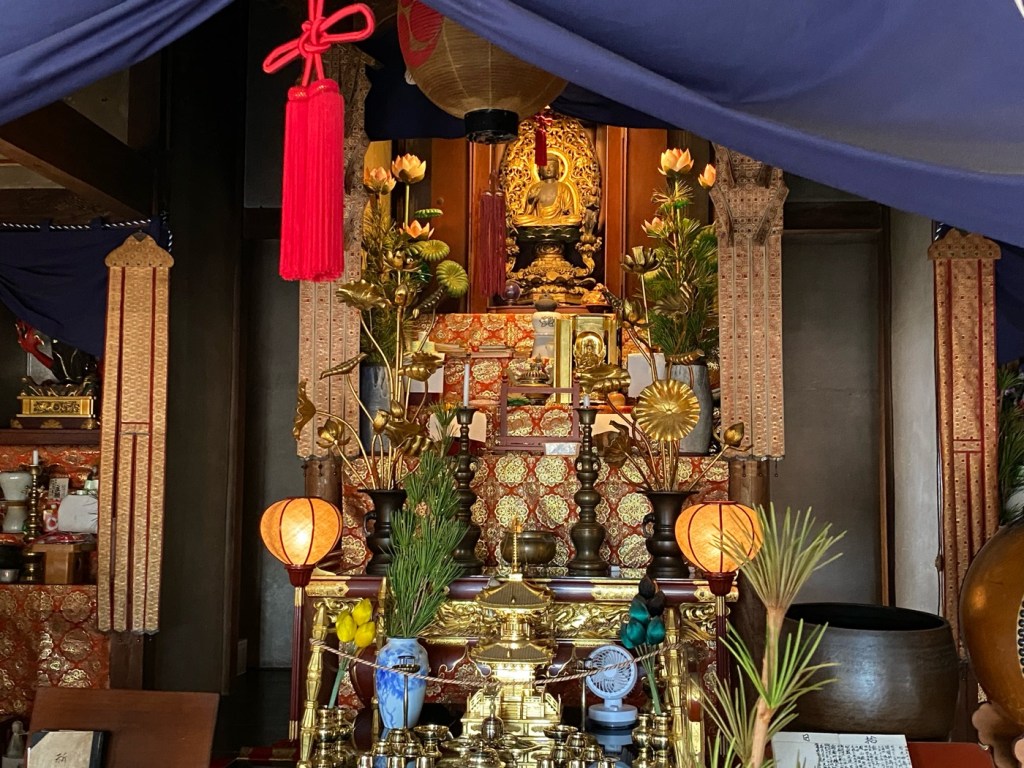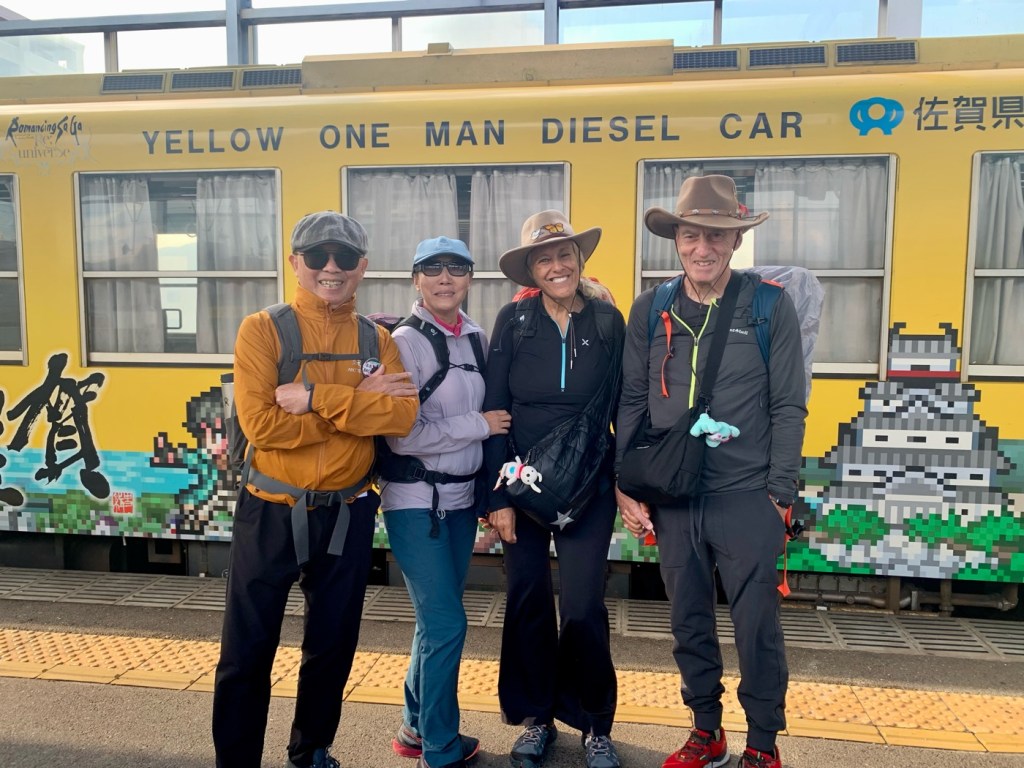Day 16 - Taku to Takeo Onsen, The Kyushu 108 Temple Pilgrimage, Japan






















































Day 16 - Taku to Takeo Onsen, The Kyushu 108 Temple Pilgrimage, Japan
This morning we had a breakfast buffet in our hotel.
We then packed our backpacks and got ready for a day of walking in the sun, carrying our heavier backpacks.
Wendy’s backpack weighed only 4 kilograms.
I envied the lightness of her backpack.
I know that she is only going to walk for a few days, while we will be walking into winter, but she was able to pack a lot of all -weather clothing into her backpack and still keep it light.
My own electronics and toiletries weigh a lot.
Wendy carries only 4 items of toiletries in her backpack, yet her face and hair always look so perfectly kept.
Even early in the morning, it was already warm.
After a couple of hours of walking, we stopped for a rest at a small shrine that had a wooden platform to sit on and a covered roof that offered us shade.
Since Joseph and Wendy are walking with us, I wanted them to enjoy the nicer roads, and often I stopped during the day to consult them about which route we should take.
But the truth is that walking can be a tedious experience, even when walking through a beautiful landscape.
Just the act of going so slowly and putting one little foot in front of the other is a constant reminder that you’re living in contradiction to the fast-paced world we normally live in.
We are usually so efficient with our time, trying to get things done quickly and very efficiently.
But a pilgrimage can be seen as a waste of time, energy and money.
But why does walking all day in a pilgrimage end up feeling like an accomplishment, and a step towards greater realization…
I didn’t have to worry about them having fun, because they know how to bring joy into their every day lives.
When we passed by a man gardening in his garden, Joseph jumped into the field and helped him weed, making all of us giggle.
Walking long distances, you are bound to pass by less pretty sections and sometimes through car tunnels where the cars speed by.
At this tunnel, at least we had sidewalks to walk on when we went through the tunnel.
The area around our first temple of the day is surrounded by a few golf courses spread through the hills.
Temple # 61, Koyaji Temple, is located on Mt. Fumyo.
Before the development of all the residential housing in the area, it was an isolated mountain temple.
It was established in the year 806 A.D. when Kobo Daishi returned to Hakata, Kyushu, after his studies in China.
He traveled around Kyushu island, and remarked that this place resembled the landscape of the famous Buddhist temple-studded mountains of Mt. Koya-San.
The famous Koyasan mountain is located East of Osaka Prefecture in northern Wakayama.
Nowadays, Koyasan is a World Heritage site, dedicated to esoteric Buddhism with 52 temples offering Buddhist lodging for visitors and an opportunity to experience vegan cuisine and meditation.
This temple we visited started out as a grass hermitage.
At that time, the Saga Plains were nothing but a vast wilderness.
The ambition was to cultivate the land and increase the population.
As always in the olden days, children were free labor, but farmers needed healthy, strong children who could work in the fields and keep the granary.
A statue of the Goddess Kannon was carved and enshrined in the temple.
It was said that those who prayed to this Kannon would have a safe delivery and a child who would grow up healthy.
To this day, people come here to pray for the health of their children and for safe childbirths.
The temple has many stone statues enshrined around the lush landscape.
It is built on a steep slope with a pagoda on the top.
The pagoda is connected to the main hall by a beautiful covered wooden corridor that is full of hanging copper wind chimes.
As we walked through, the bells made soft music welcoming us to this sacred place.
Inside the pagoda are enshrined many small statues of Fudo-Myoo, all made of wood.
A brass bell hangs from the ceiling and it is said that if you hit it once and make a wish, it will come true.
I had no doubt what I wanted to wish for…
I have been watching the news for the past few days before bedtime, and couldn’t fall asleep after seeing all the dreadful pictures of the horrible war that is unfolding in Gaza and Israel.
I closed my eyes, hit the bell once and prayed for PEACE, PEACE and nothing but PEACE for that region.
In the main hall, we chanted the Heart Sutra while the priestess stamped our book and scroll.
She complimented our chanting as she put on her regal robes, getting ready to perform a private puja ritual for a lady who came to pray.
In the early-modern times, the temple was a haven for any culprit who ran into the precincts of Koya-ji Temple.
It was believed that coming here was a sign of repentance and that they would be forgiven for their sins.
In the ancient documents, it was mentioned that many generations prayed at this temple and that it later came under the protection of the Saga Taku clan.
In the garden, there are more than 1,000 Rhomsonge plants.
It is a rare alpine plant that blooms here from the beginning of April every year.
Nobody knows how it got here or when it was first planted, but the plants in the temple date back more than 300 years.
From there, it was a shorter walk to our second temple of the day, Temple #102 Henshozan Komyoji Temple, located on the eastern side of Takeo Onsen town.
Takeo Onsen has been popular as a healing place for many generations.
It is a well established old hot spring resort town.
Komyo-ji Temple is known to enshrine the Buddha of healing Nanmu Yakushi, who helped people heal from various diseases.
The local people believe that he is the guardian of the hot spring.
Originally from Shikoku island, a branch of that temple was established here in Takeo in the year 1893.
At that time, the chief priest led more than 420 temples in the city, and many people worshipped here.
We saw many stone Buddhas clothed in handmade red breastplates on the grounds, but nobody was there to stamp our books.
The main hall was open and we all got in.
A table was set up with clementines and sweets for visitors.
We found the box with the stamps and we stamped our own books.
After praying and chanting, we sat to rest and eat some clementines before continuing our walk.
I was tired and we hadn’t passed by a place to eat lunch, so we decided that we would eat an early dinner, at a nearby conveyer-belt sushi restaurant called Shushiro.
I was wearing compression socks which I had never worn before.
The top of my feet felt hot and burning all day.
When I took off my shoes I had water blisters on top of my toes on both feet.
Perhaps it was the combination of the heat, the heavy backpacks and the compression socks that squeezed my toes, that caused it, and I decided not to wear these socks again.
From Takeo, we took a bus to Ureshino Onsen, where we will stayed for 3 nights.
We will return back to Takeo to cover the walking distance and to visit more temples here.
In Ureshino, we were warmly welcomed at our hotel and offered sparkling wine as a welcome drink.
We celebrated our walk today, soaked in the hotel’s hot springs and slept very well.
Sending you love and strength,
Tali
Stats: 29,567 steps
Today’s walk: 20 km
Kilometers walked to date: 281.5
Temples visited:
Mt. Fumyo Koyaji Temple #61
Henshozan Komyoji Temple #102